Create a free profile to get unlimited access to exclusive videos, sweepstakes, and more!
Comet ISON Is (So Far) Living up to the Hype

Hoping against hope, I was starting to dare think that maybe, just maybe, the comet C/2012 S1 (ISON) might live up to the hype that it will be a spectacular comet.
Sometimes, dreams do come true. Check. This. Out.
Holy sublimation! That ridiculously beautiful photo was taken by the outstanding UK astrophotographer Damian Peach, using a 20 cm (8â) telescope on Nov. 15, 2013. You definitely want to see the high-res version.
The comet has been getting brighter over the past few weeks, but then a few days ago had a sudden flash of activity, an outburst that increased its brightness by several times. At the same time, the tail of the comet went from being just sort of one big fuzzy thing to having several separate streamers.
Comet ISON is making its first (and perhaps only) dive into the inner solar system, and even under the best of circumstances comets are hard to predict. Iâve been very cautious with my optimism (and pessimism) for ISON, but it does look like itâs starting to perform for us. Mind you, it may still disintegrate on its way down to its Nov. 28 date with the Sun, but at least until then we can see some amazing behavior from it.
Hereâs a shot of it by Michael Jäger, taken from Austria on Nov. 12, 2013:
As you can see, just a few days ago there was one main tail and one thinner tail. If you go back in time just a little bit more, to Nov. 8 â mind you, just one week before Peachâs picture above was taken â the comet was far less detailed:
That picture is by Adam Block in Arizona at the Mt. Lemmon SkyCenter. As you can see, a week makes a huge difference.
So what happened?
The cometâs getting closer to the Sun is what happened. A comet is essentially a bunch of rocks and dust mixed in with ice; the ice is what we normally think of as gases or liquids on Earth like carbon dioxide, carbon monoxide, ammonia, and water. These are frozen when in the depths of space, but as the comet approaches the Sun, the warmth penetrates the cometâs surface to where there are big repositories of ice. They turn directly from a solid into a gas (a process called sublimation), and can burst out. The material expands, reflects sunlight, and the comet gets much brighter.
But thereâs more. Dust mixed in with the gas blows off the comet, forming the fuzzy "coma" around it, and then follows behind in the cometâs orbit, forming the long, wispy tail. In general, that dust tail looks yellowish or red, since it is reflecting sunlight.
As the comet nears the Sun, though, the solar wind slams into the gas emitted by the comet, exciting the electrons in the gas atoms, or even ionizing the gas â stripping it of an electron or two. As the electrons dance with their parent atoms, they emit light, generally in the green or blue part of the spectrum. Not only that, but the solar wind is traveling very rapidly compared to the cometâs own motion, so it blows the ionized gas particles straight back, away from the Sun. So we can get more than one tail: the yellow dust tail, and a vibrant green/blue ion tail, which is generally much straighter and narrower.
The ion tail can be beautifully structured depending on how steady or how turbulent the solar wind is. A strong burst of wind from the Sun can even detach the ion tail, causing it to literally separate from the comet and drop away. Generally, once the wind calms down again, another ion tail (or tails) will grow.
Right now, ISON is roughly 80 million km (50 million miles) from the Sun, already closer to the Sun than Venus, and itâs dropping fast. The Emory University of Physics has this cool real-time ISON calculator which shows you how far it is from the Sun and Earth, and the heliocentric distance is dropping, well, like a rock. Itâs currently moving at about 50 km/sec, and that speed will increase to a whopping 600+ km/sec when it skims the surface of the Sun on Nov. 28!
It will continue to brighten as it does so, but it will also get a bit harder to see since it will also be near the Sun in the sky. Right now the comet is close to the eastern horizon before dawn, and is bright enough to see with the naked eye (though the nearly-full Moon setting in the west may make it a bit harder to see). Binoculars will help a lot, and in fact right now the comet is near the bright star Spica in the constellation of Virgo, providing a signpost for you. Seiichi Yoshidaâs web page has a finder chart if you want to go look. [Note: There are actually four comets up in the sky right now, if you want to challenge yourself a bit.]
After Nov. 28, the comet will take a right angle turn in the sky, swinging around the Sun and then blasting northward in the evening sky. It will be better placed for seeing for those of us north of the equator, but it will also fade as its distance from the Sun increases, though how rapidly no one knows. And this is assuming it even survives its encounter with the Sun! It very well may not.
As Iâve said before, comets are like cats: predicting them is a losing game. The best thing to do is to watch and see, and I plan on doing lots of both.
And if you get good photos of the comet, please let me know! Obviously, ISON has no problems posing prettily for us.


























